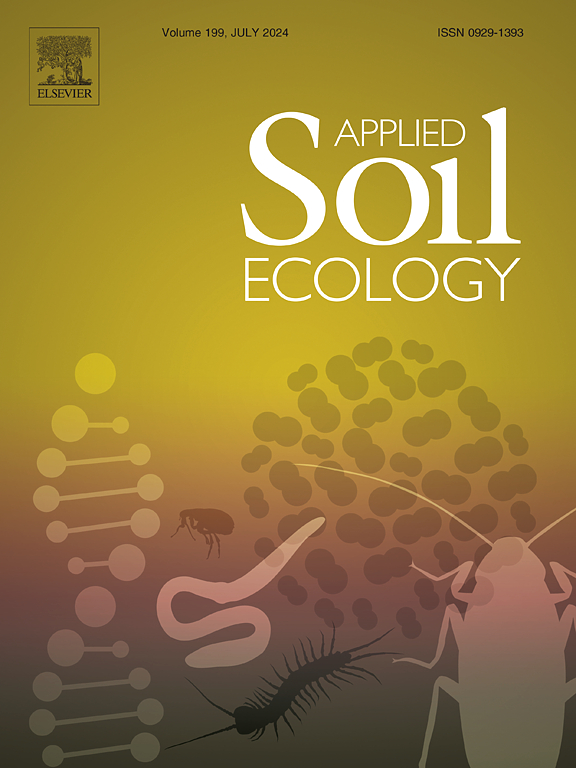森林转化改变了土壤有机质的微生物分解
IF 5
2区 农林科学
Q1 SOIL SCIENCE
引用次数: 0
摘要
土壤微生物通过分解植物残体和微生物坏死块来维持碳(C)平衡。森林砍伐对土壤中微生物介导的有机物分解机制和因子的影响尚不清楚。采用空间-时间替代法对中国亚热带地区6个样地的原生林、人工林和农田表层土壤(0-20 cm)进行了采样。宏基因组测序结合碳水化合物活性酶(CAZyme)数据库对森林砍伐下微生物c降解潜力进行了追踪。森林转换改变了c -降解微生物的群落组成,导致低营养酸杆菌群向其他低丰度分类群的优势转变。退耕还林对微生物c降解潜力的影响强于人工林。森林转化为农田后,参与降解植物源半纤维素、纤维素和细菌源肽聚糖的基因丰度增加了11% - 19%,而编码降解植物源木质素和真菌源葡聚糖的基因丰度下降了20%以上。这表明微生物对碳的降解偏好从顽固化合物转向不稳定的底物。森林砍伐后土壤全磷含量和pH值的增加以及碳氮比的降低是导致CAZyme c降解基因变化的最重要因素。c -降解基因部分解释了微生物酶的活性,如GH39 (β-木糖苷酶)与相应酶活性的降低。总体而言,森林转换后微生物C降解基因和土壤性质的变化改变了微生物C降解偏好,并通过土地利用变化影响土壤C循环。本文章由计算机程序翻译,如有差异,请以英文原文为准。
Forest conversion alters microbial decomposition of soil organic matter
Soil microorganisms are critical to maintain carbon (C) balance by decomposition of plant residues and microbial necromass. The effects of deforestation on mechanisms and factors of microbially mediated decomposition of organic compounds in soil remain unclear. Topsoil (0–20 cm) was sampled from native forests, plantations, and croplands at six sites in subtropical China using space-for-time substitution. Metagenomic sequencing combined with the Carbohydrate-Active Enzymes (CAZyme) database was used to trace microbial C-degradation potentials under deforestation. Forest conversion altered the community composition of C-degrading microorganisms, leading to a shift from oligotrophic Acidobacteria to dominance of other low-abundance taxa. The effects of forest conversion to cropland on microbial C-degradation potentials was stronger than that of conversion to plantations. After forest conversion to cropland, the abundance of genes involved in the degradation of plant-derived hemicellulose and cellulose and bacteria-derived peptidoglycan increased by 11 %–19 %, whereas the abundance of genes encoding the degradation of plant-derived lignin and fungi-derived glucans decreased by more than 20 %. This indicated a shift in microbial C-degradation preference from recalcitrant compounds to labile substrates. The increase in total phosphorus content in soil and pH, and the decrease in the carbon-to‑nitrogen ratio after deforestation, were the most important factors driving the change of CAZyme C-degradation genes. The C-degradation genes partially explained microbial enzyme activities, such as decreased of GH39 (β-xylosidase) with the corresponding enzyme activities. Overall, changes in microbial C-degradation genes and soil properties after forest conversion shifts microbial C-degradation preferences and impact soil C cycling by land-use change.
求助全文
通过发布文献求助,成功后即可免费获取论文全文。
去求助
来源期刊

Applied Soil Ecology
农林科学-土壤科学
CiteScore
9.70
自引率
4.20%
发文量
363
审稿时长
5.3 months
期刊介绍:
Applied Soil Ecology addresses the role of soil organisms and their interactions in relation to: sustainability and productivity, nutrient cycling and other soil processes, the maintenance of soil functions, the impact of human activities on soil ecosystems and bio(techno)logical control of soil-inhabiting pests, diseases and weeds.
 求助内容:
求助内容: 应助结果提醒方式:
应助结果提醒方式:


